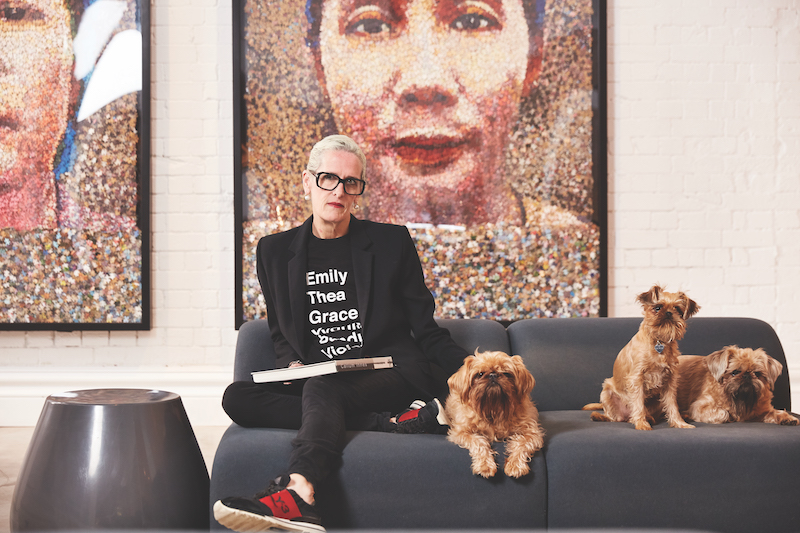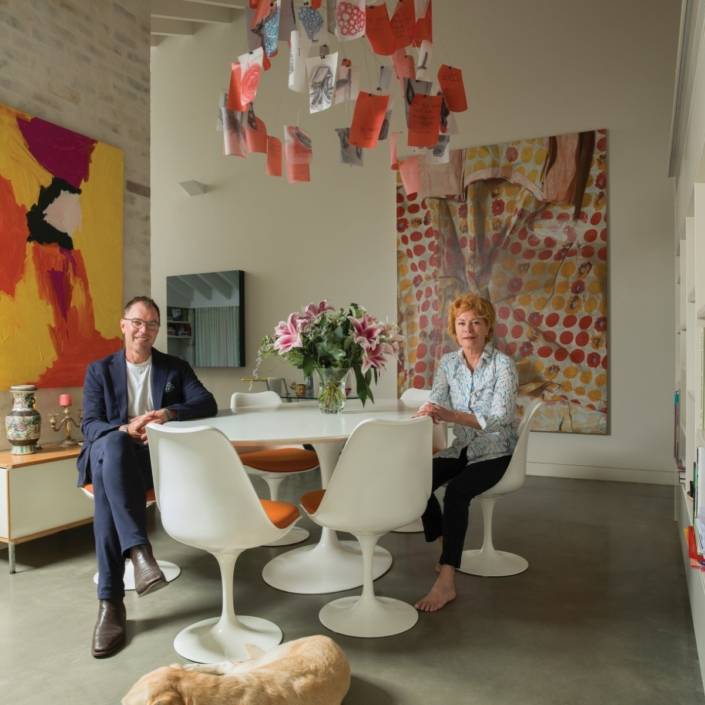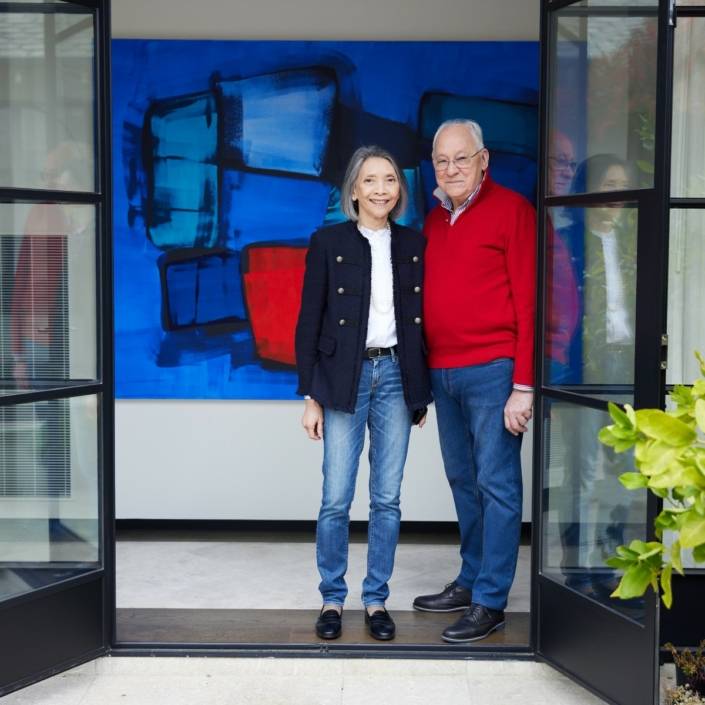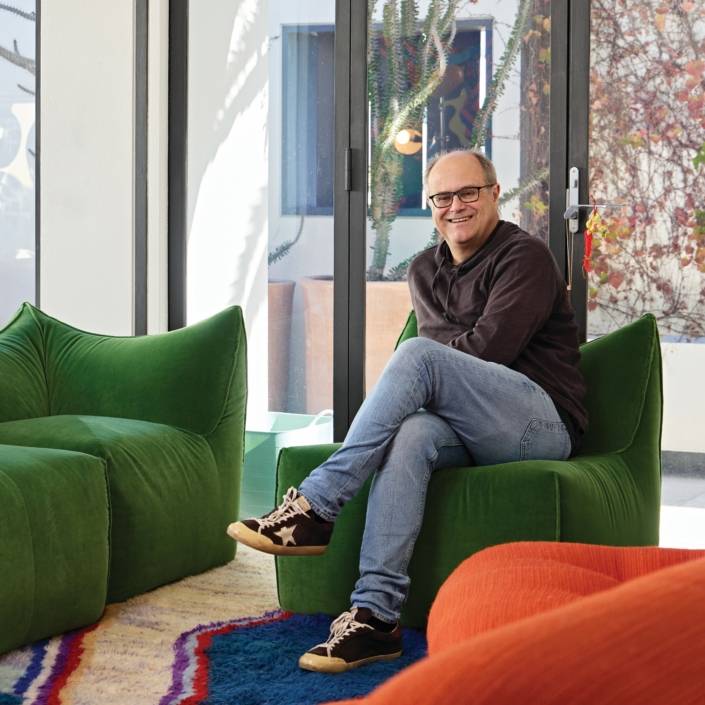Sue Cato: Level Up
You’d be forgiven for mistaking the home of collector Sue Cato for a top Australian art institution.
Words: Helen McKenzie
Photography: Nick de Lorenzo
SUE CATO does not “dabble” in the arts. She collects with fervour, usually has between 10 and 15 works out on loan and gives countless hours to art boards – Carriageworks, Sydney Contemporary Art Fair (and, until recently, the Museum of Contemporary Art). She lives in a home that more closely resembles a gallery than a residence and possibly, the ultimate sign of her devotion to the cause, she has sat for an Archibald portrait. The look on Cato’s face when Luke Cornish’s portrait of her in the 2019 prize is mentioned is an expression of mixed emotion. Clearly, her preference would be not to be so personally exposed, but as she says, “What could I say? Luke is really talented and the work he does in war zones with kids makes him a really special, good human. Of course, I said yes.” Cato looks a little steely in the large and powerful portrait. “[artist Ben] Quilty, Luke and I joke that hopefully it will look current in 15 years’ time!” Cato laughs.
Cato’s day job involves managing strategic communications for national and international corporations, including crisis management and mergers and acquisitions. The work demands objectivity and clarity. “If you are in the middle of a hostile take-over and there are lots of high spirits, you need to take the emotion out of the situation; that is your focus,” she explains. Her background as a political staffer might have given her a background in diplomacy, “or not!” she suggests with a smile.
Professionally, Cato may be tasked with taking the heat out of a situation, but when it comes to buying art her senses must be ignited. “For me it’s a physical as well as an intellectual response. I find it incredibly energising and it makes my mind race. You can feel your heart thump when you see really great work – like having a power cord plugged in.” And her response is clearly not short-lived. As we roam throughout the home she shares with husband of 10 years Vaughan Busby and their three adored Brussels Griffon dogs – Comet, Callie and Lucie(fur) – Cato’s enthusiasm for works collected decades ago is obvious and fresh. Looking at a wall of seven Bill Henson photographs, Cato marvels at the work: “He captures the human moment between light and dark, age and youth. It is so exciting.”
Henson is not the only artist Cato has collected in depth; she also has several works by Ben Quilty. “There are some artists that you respond and respond to. The Quiltys are from different periods and you can see his growth – if you look back to the Margaret Olley phase it was almost like he was getting his bag of tricks together and he has taken it to a whole new level, like learning to write. He now has his language and he is doing the most beautiful deep works, it has been such a pleasure watching him get stronger as an artist.”
But Cato insists that in-depth collecting has not been a deliberate strategy. The Cato collection comprises many museum-quality works by leading lights from the local and international contemporary art world – David Noonan, Julie Fragar, Shaun Gladwell, Guan Wei, Callum Innes and Danie Mellor, to name a few, plus works by Grace Cossington Smith and Colin McCahon that are pure treasures.
For Cato, it is a collection that undoubtedly evokes pride in Australian artists. It also makes her wonder, after a recent trip to the Venice Biennale, why more of our best artists were not represented in the Arsenale section. “It would be interesting to understand why more of our people didn’t get a run,” she says. “Rather than getting cross about it, ask the questions.” Cato’s comments go to her thesis that for Australian artists to make it on the world stage – and also earn more for their work – they need International curatorial recognition. Cato postulates that “if their works are included in Frieze, or various biennales, then success will follow. It really is curatorial recognition and institutional recognition that is the first priority.”
While demurely declining to put a figure to the number of works in her collection, there is no talk that while the walls of her home – a converted historic light power station in an inner Sydney suburb – appear fully accommodated, that Cato’s collecting will cease. Cato sees no point in storing art, some of her four elder sisters happily “volunteer” exhibition space in their homes. There are also many works on the walls of the Cato & Clegg office. Additional wall space will become available when plans to extend into a section of her home that had previously been leased are realised. The fervour continues.
This article was originally published in Art Collector issue 89, JUL-SEP 2019.






